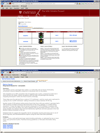The 1200 patients project: creating a new medical model system for clinical implementation of pharmacogenomics
- PMID: 22929923
- PMCID: PMC4482357
- DOI: 10.1038/clpt.2012.117
The 1200 patients project: creating a new medical model system for clinical implementation of pharmacogenomics
Abstract
The paradigm of individualized drug therapy based on genetics is an ideal that is now potentially possible. However, translation of pharmacogenomics into practice has encountered barriers such as limited availability and the high cost of genetic testing, the delays involved, disagreements about interpretation of results, and even lack of understanding about pharmacogenomics in general. We describe our institutional pharmacogenomics-implementation project, "The 1200 Patients Project," a model designed to overcome these barriers and facilitate the availability of pharmacogenomic information for personalized prescribing.
Figures


References
-
- Ratain MJ. Personalized medicine: Building the gps to take us there. Clin Pharmacol Ther. 2007;81:321–322. - PubMed
-
- Greco PJ, Eisenberg JM. Changing physicians' practices. N Engl J Med. 1993;329:1271–1273. - PubMed
-
- Cantor CR. Company profile: Sequenom, Inc. Pharmacogenomics. 2012;13:529–531. - PubMed
-
- Stanek E, et al. Who are adopters of pharmacogenomics among U.S. Physicians?; Presented at the 59th Annual Meeting of The American Society of Human Genetics; 2009. [abstract].
-
- Altman RB. Pharmacogenomics: "Noninferiority" is sufficient for initial implementation. Clin Pharmacol Ther. 2011;89:348–350. - PubMed
Publication types
MeSH terms
Substances
Grants and funding
LinkOut - more resources
Full Text Sources
Medical

